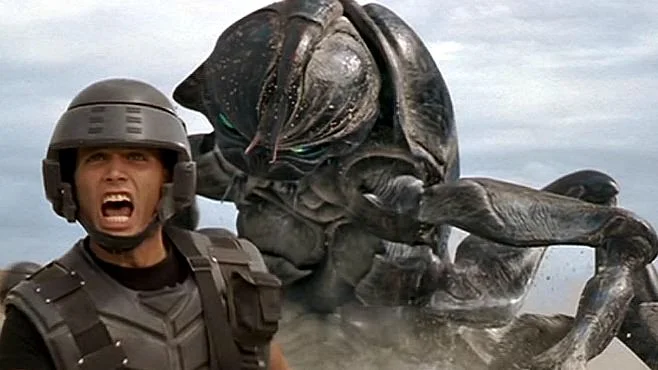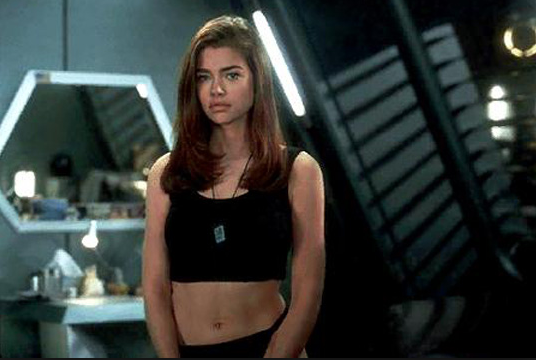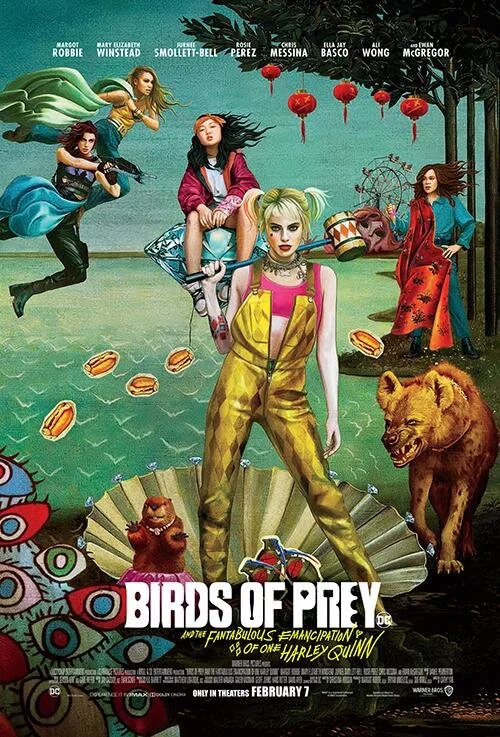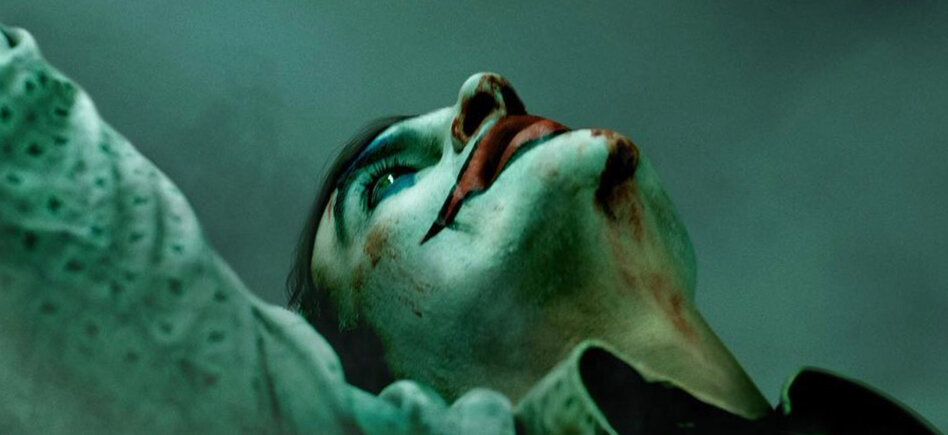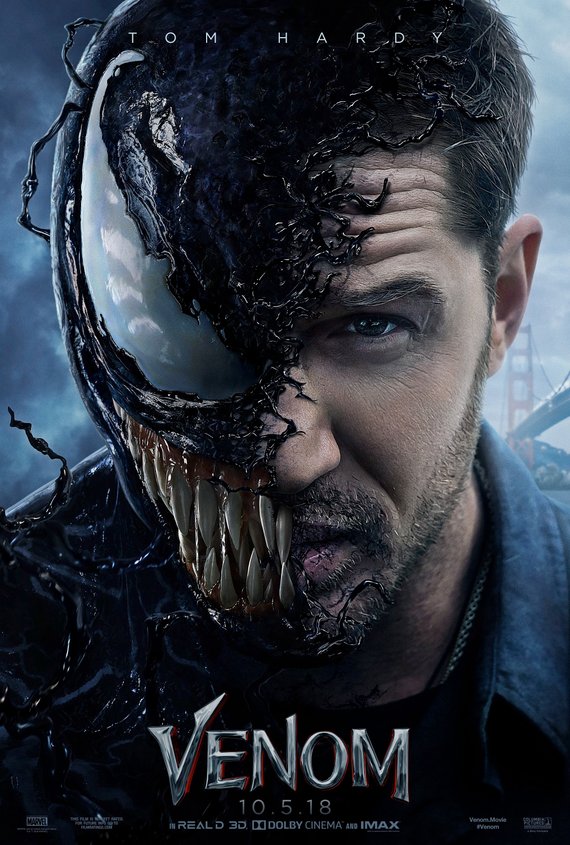The moment when you discover what Starship Troopers is really about is one of the great eureka moments in the life of any young movie dork. I’ve got vivid memories of sneaking into and staggering out of a suburban multiplex in 1997 and sputtering, “What the fuck was that?” To my young self, it was basically Saved by the Bell plus giant alien bugs cutting people in half. And since I liked the spectacle of giant-monster-related carnage, I wasn’t even mad. I was just confounded. Like: Why were all the human characters so stupid? Could it be possible that a movie so big and expensive could also be so blindingly, knowingly dumb? And how is someone going to make a grand-scale blockbuster with Doogie Howser, MD as the most famous person in the cast. (Neil Patrick Harris was still unequivocally Doogie at that point; he would remain Doogie until the first Harold and Kumar flick. Look, 1997 was a long time ago.) And when a friend’s mom told me, years later, that the movie was really about fascism and militarism, I absolutely thought that person was full of shit (sorry Ms Spurlin). But that’s exactly what it is. Starship Troopers may be the greatest joke ever played on the American movie going public.
Written and Directed by the demented genius filmmaker Paul Verhoeven who grew up in the Nazi-occupied Netherlands, an experience he’d explore more straightforwardly when he went back to the Netherlands and made the great 2007 WWII melodrama Black Book after his Hollywood career ended. When he started work on Starship Troopers, it was supposed to be a sci-fi movie called Bug Hunt at Outpost Nine, and I think we can all agree that that’s a superior name. But someone explained to the execs in charge that Bug Hunt, with its interplanetary war against giant insects, had a lot in common with Robert Heinlin’s right-wing 1959 sci-fi novel Starship Troopers. So they bought the rights and changed a few things so that Bug Hunt would now be an adaptation, sort of like how Die Hard With a Vengeance was a generic thriller rewritten to be about John McClane. But when Verhoeven tried to read the book, he claims that it made him “bored and depressed,” and he never finished it. So the director here had a whole lot of contempt for the movie he was supposed to be making, and that contempt comes through very, very clearly in the finished product.
When we first meet the movie’s shiny, plasticized teenage heroes, they’re in history class, studying “the failure of democracy”—and you might not notice at first, since you’re watching an incredibly young and hot Denise Richards (pre Wild Things, so you could actually imagine what she looked like without clothes) and the hilarious wasted potential slab of meat Casper Van Diem flirting on their proto-iPads. They live in Buenos Aires, and they all have Spanish names, but they’re all as white as Christmas. Van Diem plays some sort of futuristic arena football that involves doing lots of wire-controlled flips. Neil Patrick Harris has a pet ferret named Cyrano who he psychically controls. In science class, these kids banter while dissecting giant bugs in a truly disgusting classroom scene that plays like something Troma might’ve made if they ever had the budget. Based on everything in these early scenes, it’s amazing that we could ever see this movie as anything other than a dark, fucked-up comedy. But studio action movies in the ’90s were so routinely stupid—remember, this was the year of the Matthew Broderick “that’s a lot of fish” Godzilla remake.
Along the way, the movie features futuristic newsreel footage that straight up quotes Nazi propaganda films. Kids fighting over guns! The government advertises public executions on prime time TV! Newscasters talk about the need to straight up destroy star systems occupied by the enemy “bugs” because they could present a threat! It’s clear that the humans struck first. There’s a drill sergeant character that goes way beyond the standard movie stereotype, actually intentionally maiming the soldiers he’s treating. I don’t know how teenage me missed all these obvious-in-retrospect clues, but I don’t have to feel too bad about it, since most of the critics who reviewed Starship Troopers at the time also had no idea what the movie was doing.
About halfway through, the movie abruptly switches up styles and becomes a long, grisly series of battle scenes on bug-controlled desert planets. Giant bugs dive out of the sky to chop off heads. They breathe fire and slowly immolate bodies. Cameras pan lovingly over entire fields of dismembered corpses. A closing spaceship door cuts a lovely woman in half. Michael Ironside sticks his mechanical fingers into a head wound, and then gravely looks up and declares, “They sucked his brains out.” These scenes are way more gnarly and brutal than what you’d see in virtually any Hollywood studio movie of the time—or, come to think of it, of any time. And the movie shows these scenes of awful death on a mass scale without ever changing its whole high-space-adventure golly jee wiz tone. When characters die, their friends furrow their brows, maybe say a few words of goodbye, and then it’s off to kill more bugs.
And it helps the movie’s repeat watchability that, judged on pure action-movie merits, those bug-battle scenes are extremely fucking good. It shouldn’t be a surprise. Verhoeven had, after all, directed the “original” Robocop and Total Recall, two of the greatest and nastiest action movies of all time. This was the beginning of the whole CGI-movie-spectacle era, and we’ve learned, in the years since, how hard it is to show humans fighting computer cartoons and make them look like they exist in the same universe. But even working with relatively primitive technology, Verhoeven pretty much pulled it off. The movie’s spaceships still look like trash, but the bugs themselves have aged pretty well—especially the truly disgusting ones, like the brain bug, with its vaginal-opening mouth and its brain-sucking spike. And as with every Verhoeven movie, the movie is stocked with all these scarily vivid faces— nobody has ever gotten more mileage from Jake Busey’s teeth. And it’s even more fun to watch now that you’ll recognize some of those faces: Dean Norris! Amy Smart! Carver from The Wire!
But then, the movie had to be fun to watch. For its satire to have any bite at all, it had to succeed on pure action-movie terms, and it did. Verhoeven wasn’t the type of satirist to put up blinking arrows that made everything he did obvious. Instead, he disguised his nasty poison pill of a movie as a particularly perverse piece of American blockbuster entertainment. He used Hollywood’s machinery to make Hollywood look unconscionably stupid. And 18 years later, the most amazing thing about Starship Troopers is that it ever had a chance to exist.

